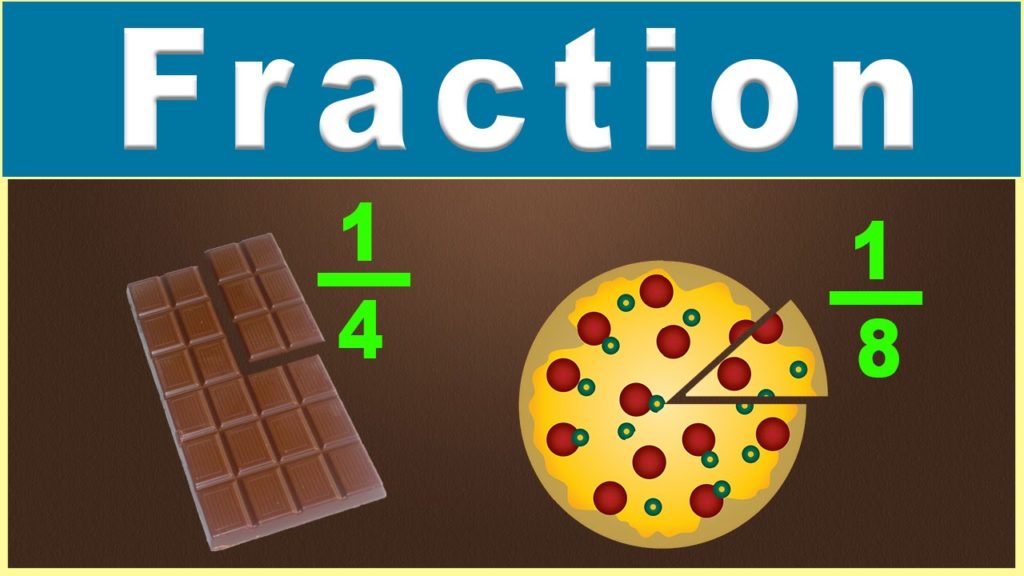Back to: MATHEMATICS JSS1
Welcome to class!
In today’s class, we will be talking about fractions. Enjoy the class!
Fractions

What Is a Fraction?
Fractions give some people nightmares, but this doesn’t have to be you. Keep watching this video lesson, and you will come out with a better understanding of fractions. And hopefully, you won’t feel so afraid of them.
We begin with a definition of what fractions are. A fraction simply tells us how many parts of a whole we have. You can recognize a fraction by the slash that is written between the two numbers. We have a top number, the numerator, and a bottom number, the denominator. For example, 1/2 is a fraction. You can write it with a slanted slash like we have or you can write the 1 on top of the 2 with the slash between the two numbers. The 1 is the numerator, and the 2 is the denominator.
Proper fraction:
Fractions whose numerators are less than the denominators are called proper fractions. (Numerator < denominator)
For examples:
2/3, 3/4, 4/5, 5/6, 6/7, 2/9, 5/8, 2/5, etc are proper fractions.
If two parts are shaded. The total number of equal parts is 3. Therefore, the shaded part can be represented as 2/3 in fraction. The numerator (top number) is less compared to the denominator (bottom number). This type of fraction is called a proper fraction.
Similarly,
If three parts are shaded. The total number of equal parts is 4. Therefore, the shaded part can be represented as 3/4 in fraction. The numerator (top number) is less compared to the denominator (bottom number). This type of fraction is called a proper fraction.
Improper fraction:
Fractions with the numerator either equal to or greater than the denominator are called an improper fraction. (Numerator = denominator or, Numerator > denominator)
Fractions like 5/4, 17/5, 5/2 etc. are not proper fractions. These are improper fractions. The fraction 7/7 is an improper fraction.
Fractions 5/4, 3/2, 8/3, 6/5, 10/3, 13/10, 15/4, 9/9, 20/13, 12/12, 13/11, 14/11, 17/17 are examples of improper fractions. The top number (numerator) is greater than the bottom number (denominator). Such type of fraction is called an improper fraction.
Notes:
(i) Every natural number can be written as a fraction in which 1 is its denominator. For example, 2 = 2/1, 25 = 25/1, 53 = 53/1, etc. So, every natural number is an improper fraction.
(ii) The value of an improper fraction is always equal to or greater than 1.
Mixed fraction:
A combination of a proper fraction and a whole number is called a mixed fraction.
1 1/3, 2 1/3, 3 2/5, 4 2/5, 11 1/10, 9 13/15 and 12 3/5 are examples of mixed fraction.
In other words, A fraction which contains two parts: (i) a natural number and (ii) a proper fraction, is called a mixed fraction, e.g., 3 2/5, 7 3/4, etc.
For the number; , 3 is the natural number part and 2/5 is the proper fraction part.
In Fact, means 3 + 2/5.
Note: A mixed number is formed with a whole number and a fraction.
Property 1:
A mixed fraction may always be converted into an improper fraction. Multiply the natural number by the denominator and add to the numerator. This new numerator over the denominator is the required fraction.
Property 2:
An important fraction can be always be converted into a mixed fraction.
Divide the numerator by the denominator to get the quotient and remainder. Then the quotient is the natural number part and the remainder over the denominator is the proper fraction part of the required mixed fraction.
In our next class, we will be talking more about Fractions. We hope you enjoyed the class.
Should you have any further question, feel free to ask in the comment section below and trust us to respond as soon as possible.

Yes
when is the next class